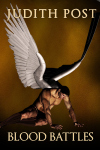Writing–Lessons Learned

Blood Battles
I finally finished the second book in the Fallen Angels series. Blood Battles will be online soon, (I’m hoping in the next week or so), but it’s taken me longer than I expected. I’ve learned a lot, writing this book. These are not words of wisdom that I’m passing along. They’re frustrations I dealt with the hard way and hopefully, you can avoid.
Number One: Know your genre. I thought I did. I was wrong. Read at least half a dozen authors, most of them best sellers, in the genre you want to write in before you begin. The reason that I qualify a few best sellers is because these are the writers who’ve hit all or most of the ingredients in the genre really well. Read a few others to see what those authors do that’s a little outside the box. Then find your own voice, what you want to bring to the genre, and be yourself.
I started out writing mysteries. When I wrote Fallen Angels, I clung to the mystery framework to structure the book. After all, a mystery has a built-in plot provider–someone’s murdered, you track suspects, and eventually you find the killer. But mixing mystery and urban fantasy wasn’t my most brilliant idea. It did, however, give me a transition to ease into my new genre–perfect or not.
Number Two: Don’t just focus on the obvious. When I first read urban fantasy, I listed kick-ass heroine, battles, a supernatural romance sub-plot, and an evil, supernatural villain as the basics for a decent book. A good weapon was a plus. But relationships are a major part of urban fantasy, too. Feelings are what lift the battles to a higher level, what make the outcomes more dramatic. The love interests often respect and admire strong women, and their courtship/relationship with the heroine is based on mutual respect (even if it’s not of the common variety).
Number Three: Repetition kills tension, no matter what that repetition is. I did almost everything wrong I could do in Blood Battles. I plotted the book so that each battle would escalate until the end. I started with a surprise attack. Then, one of the good guys dies. Then they’re tricked, etc. But guess what? Using battles to amp up the tension just got boring. It came off as a gimmick, and my beta readers (bless them) let me know. It’s like reading mysteries where the author kills someone every time the plot sags. Or people die in more grotesque ways. It gets old. I had a couple of subplots, but they didn’t affect Enoch, my protagonist, enough. They weren’t personal enough. And that’s the real key to what drives a story. The conflict has to hit your protagonist hard enough to raise his personal stakes.
Number Four: Humor’s hard. I thought I’d throw in a Don Juan vamp to make a move on Enoch’s love interest, to annoy him. I thought it might add a bit of humor, but Amado annoyed my beta readers enough, they told me to kill him. Just stake him and be done with it. Not the reaction I was looking for, so I had to completely re-vamp (a little urban fantasy humor) my Latin, undead lover.
Number Five: Rewrites can fix almost anything. I didn’t fix Blood Battles in one edit. Partly, my own fault. As authors, we can get stubborn about things we love, things that don’t work in our novel. I had to do three rewrites before I finally purged most of my mistakes and changed the focus of quite a few of my scenes. I pitched two entire subplots–that’s what the “delete” button’s for. By the time I got done, the book was a lot leaner and meaner, but I couldn’t tell if it was better or even if it totally hung together, I’d changed so much. One of my beta readers, brave woman, went throught the whole thing for me AGAIN. When she said it worked, it was a real relief.
I think it’s rare or impossible for a writer to ever write “the perfect book,” but I think I booted most of my biggest blunders. So can you. But I hope you don’t make as many mistakes along the way as I did.
http://www.judithpostswritingmusings.com





